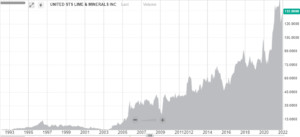U.S. Lime (USLM) Deserves Another Look
Geoff wrote about U.S. Lime back on February 18th, 2018. Focused Compounding members can read that article here: U.S. Lime (USLM): A High Longevity Stock in a Low Competition Industry
U.S. Lime at the time was trading around $75 per share. Today, the stock is at $130ish per share. Why is now a good time to revisit the company?
Consistency.
Irrespective of valuation, I really like this business. Buffett always talks about how he and Munger have filters in their head to decide instantly whether they should pass or move forward with a business. For me, the first filter is competition. This disqualifies about 99% of the businesses I look at. Will I miss a bunch of potential 10 baggers because of this?
Most definitely.
Is this bad?
Absolutely not.
If anyone comes across a company that has stable margins on a durable product and competes mainly on a regionalized bases, shoot me an email — I’ll always be interested to hear about it.
U.S. Lime fits that bill. U.S. Lime describes their competition in their 10-K as:
———————————————————————————————————————————————————————–
Competition. The lime industry is highly regionalized and competitive, with price, quality, ability to meet customer demands and specifications, proximity to customers, personal relationships and timeliness of deliveries being the prime competitive factors. The Company’s competitors are predominantly private companies.
The lime industry is characterized by high barriers to entry, including: the scarcity of high-quality limestone deposits on which the required zoning and permitting for extraction can be obtained; the need for lime plants and facilities to be located close to markets, paved roads and railroad networks to enable cost-effective production and distribution; clean air and anti-pollution regulations, including those related to greenhouse gas emissions, which make it more difficult to obtain permitting for new sources of emissions, such as lime kilns; and the high capital cost of the plants and facilities. These considerations reinforce the premium value of operations having permitted, long-term, high-quality limestone reserves and good locations and transportation relative to markets.
Lime producers tend to be concentrated on known high-quality limestone formations where competition takes place principally on a regional basis. While the steel industry and environmental-related users, including utility plants, are the largest market sectors, the lime industry also counts chemical users and other industrial users, including paper manufacturers, oil and gas services and highway, road and building contractors, among its major customers.
In recent years, the lime industry has experienced reduced demand from certain industries as they experience cyclical or secular downturns. For example, demand from the Company’s steel and oil and gas services customers tends to vary with the demand for their products and services, which has continued to be cyclical. In addition, utility plants are continuing to use more natural gas and renewable sources for power generation instead of coal, which reduces their demand for lime and limestone for flue gas treatment processes. These reductions in demand have resulted in increased competitive pressures, including pricing and competition for certain customer accounts, in the industry.
Consolidation in the lime industry has left the three largest companies accounting for more than two-thirds of North American production capacity. In addition to the consolidations, and often in conjunction with them, many lime producers have undergone modernization and expansion and development projects to upgrade their processing equipment in an effort to improve operating efficiency. We believe that our modernization and expansion projects in Texas and Arkansas, the kiln project at our St. Clair operations in Oklahoma, and the July 2020 Carthage acquisition, along with our lime slurry operations in Texas, should allow us to continue to remain competitive, protect our markets and position ourselves for the future. In addition, we will continue to evaluate internal and external opportunities for expansion, growth and increased profitability, as conditions warrant, or opportunities arise. We may have to revise our strategy or otherwise consider ways to enhance the value of the Company, including by entering into strategic partnerships, mergers or other transactions.
———————————————————————————————————————————————————————–
Anyway, read Geoff’s first writeup on U.S. Lime and then come back to this post. When you back out the $101m in cash on the balance sheet, U.S. Lime is trading around 19x FCF — which is not screaming cheap, but also not too expensive for a business that:
Has had success raising prices for the past 20 years (even as production volumes have declined)
Competes on a regionalized basis because of the price/weight of lime (For example, a lime quarry in Texas is not competing with a lime quarry in Florida)
Product is as durable as they come — going back to the roman empire
Has provable/probable reserves for the next 70 years
Will benefit from consolidation within the industry (everything Geoff layed out in his original post) — an updated report can be viewed here: https://pubs.usgs.gov/periodicals/mcs2021/mcs2021-lime.pdf
Will benefit from the new infrastructure bill
Will do well through the inflation that’s already here
ROC numbers are substantial when using EBITDA or FCF — Maint CAPEX is probably around $14-16 million a year
No debt
Stable/predictable margins
High insider ownership
3-year CAGR TR: 25%
5-year CAGR TR: 18%
10-year CAGR TR: 11%
Total return since inception: 4,065%

If I were on the board, I would push for them to take their FCF and buy back their stock. Has anyone looked at U.S. Lime recently? Let me know in the comments below.
In any event, U.S. Lime should be on your watchlist as it’s a high-quality business that should do well over the next 10 years.
